Business Scenario and Analysis
Business Context
CoolStore Website has the basic business scenario for Product Catalog, Shopping Cart, Payment Process, Inventory, Rating, and Access Control.
With Product Catalog, Buyer can browse the products list with supported filtering and sorting by product name and price functionalities. And she can see the detail of the product on the product list page by clicking on it, in the detail page, she can see a name, description, available product in the inventory, the inventory store information like stock address and location, a hot product flag (if has) and rating. SysAdmin in the system can manage the product and has the ability to assign this product to the existed inventory.
With Shopping Cart, Buyer can buy any product on the product list via the Buy button on any product. Besides, she can buy the product in the detail product page. After bought product, she should see these products in the shopping cart and the summary panel with basic information such as cart total cost, promotion item saving cost, subtotal cost, shipping cost, promotion shipping savings cost, total order amount. And whenever she buy more products or remove some products out of the cart, then the summary panel and shopping cart should be updated. After all, she can do a checkout process to pay money by clicking the Check Out button on the shopping cart page. SysAdmin can see all the shopping cart of any user so that he can enable or disable any invalid shopping cart in CoolStore website.
With Payment process, after Buyer clicked checkout button, the system will start to validate the product information, process payment, and then send an email to Buyer so that she knows about what is going on.
With Inventory, SysAdmin can manage the inventory.
With Rating, Buyer can rate any product that she thinks is good (1 -> 5 stars).
With Access Control, Buyer or SysAdmin can log on/off the system and if Buyer, she will be brought into the product catalog page, and if SysAdmin, he will be brought into the administration page.
Some of the one-off tasks need to be done when CoolStore website starts such as SysAdmin user, two Buyer users and sample data for product, inventory, rating for a few products.
Conceptual Model
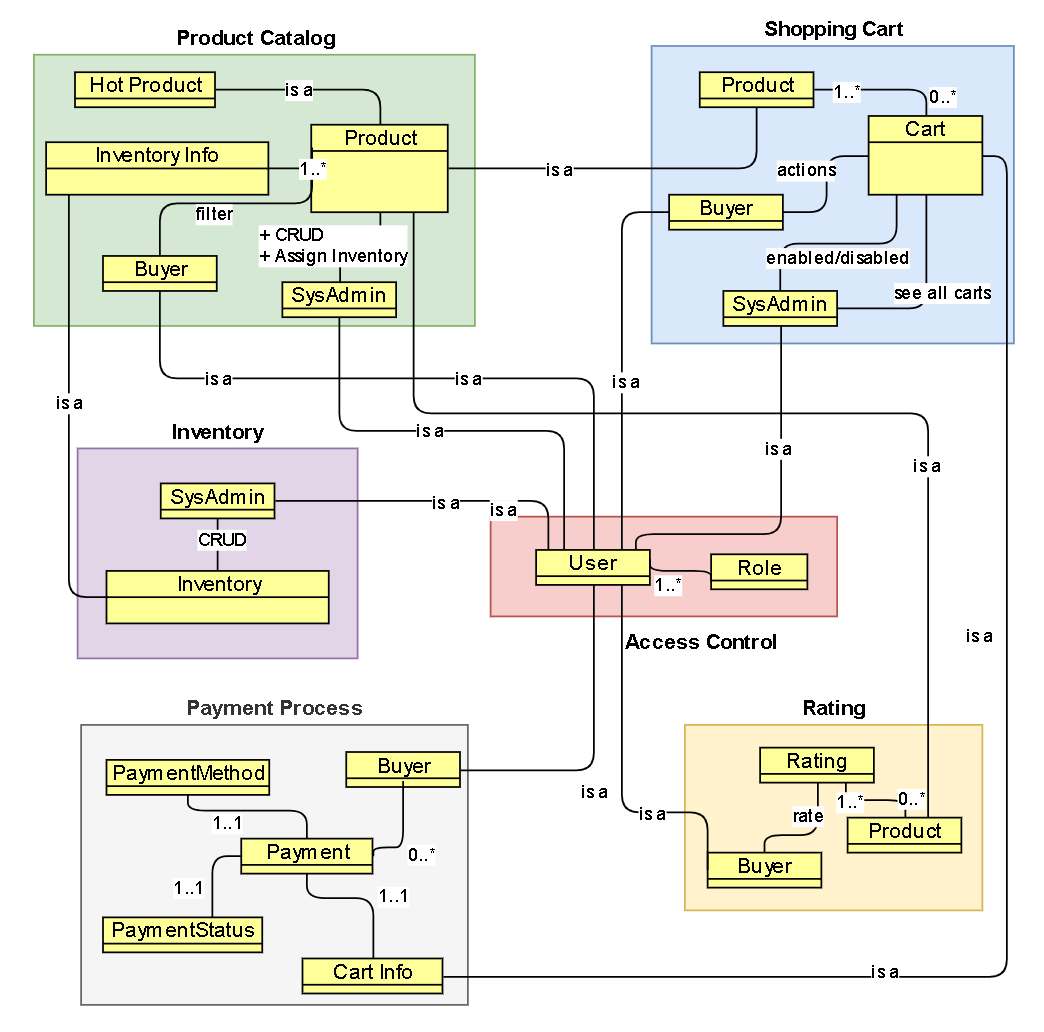
Usecase View
Product Catalog
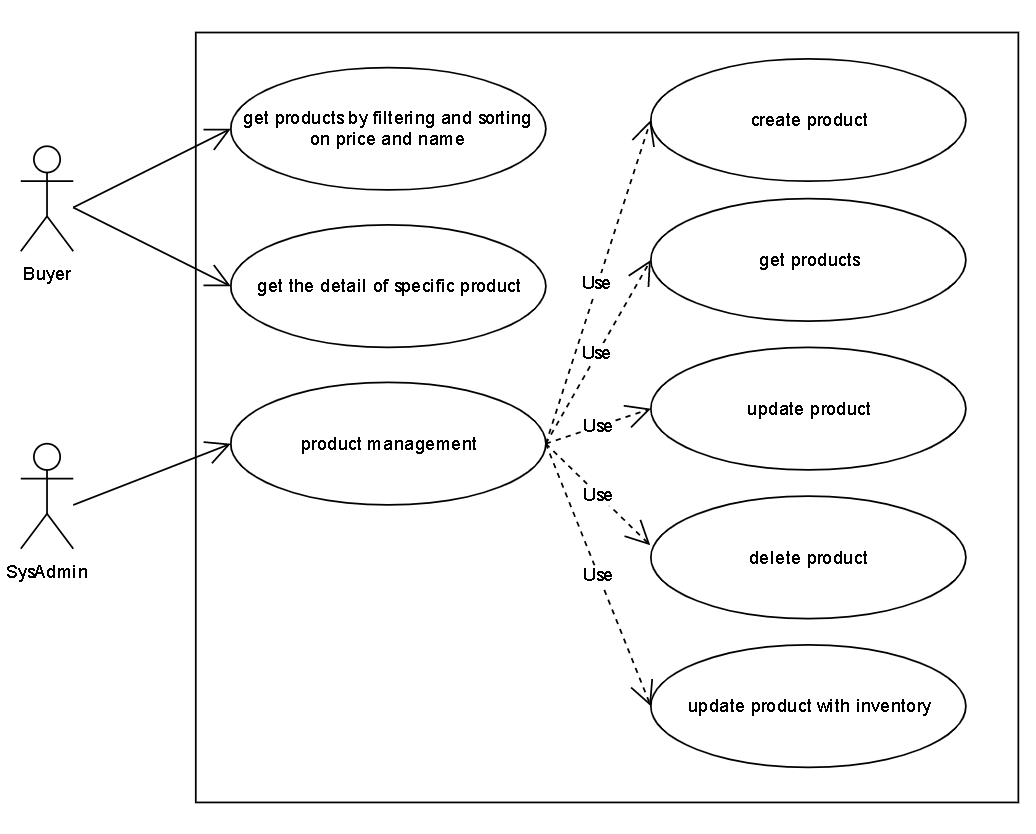
Shopping Cart
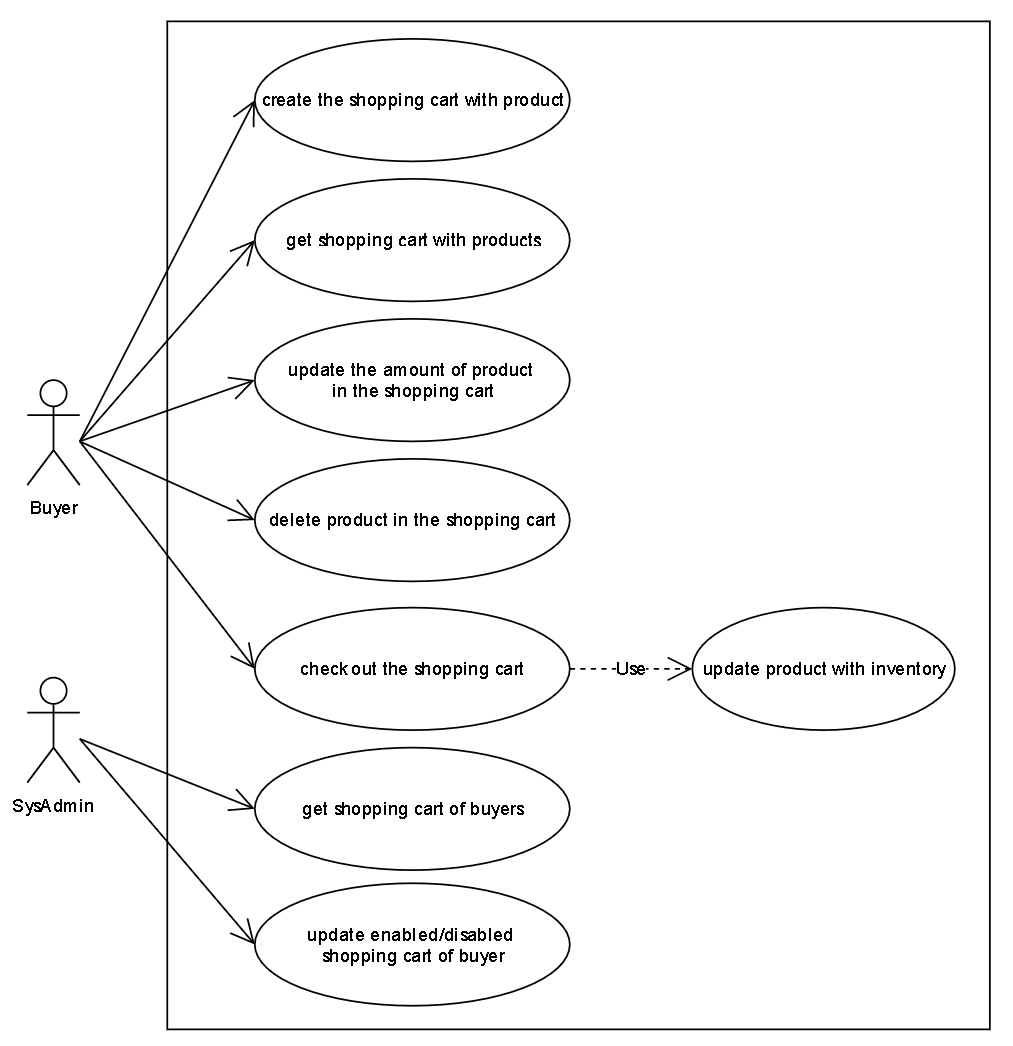
Payment Process
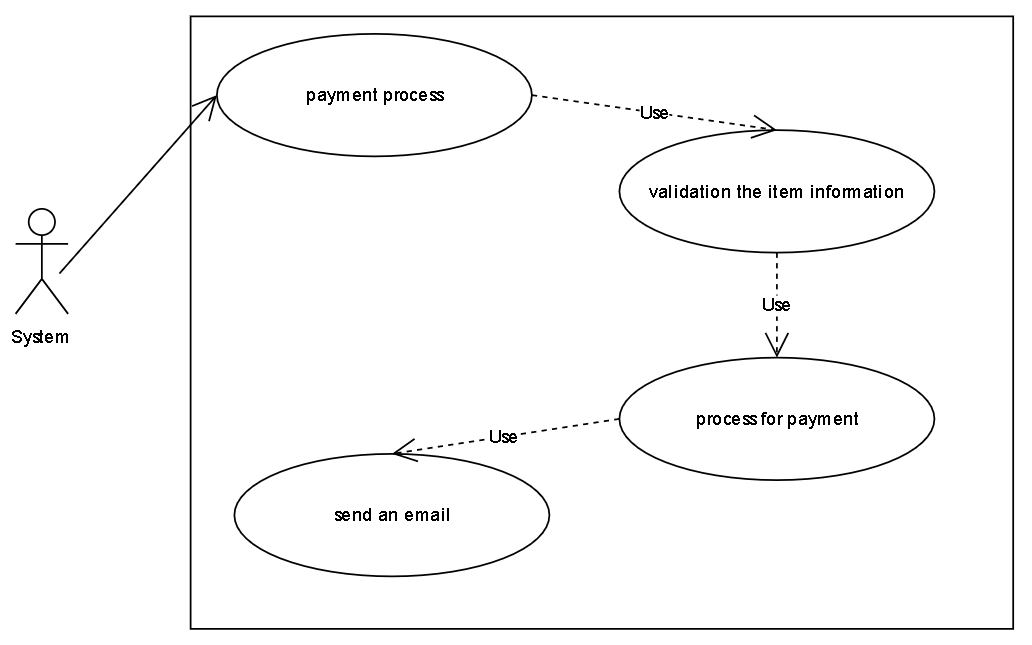
Inventory
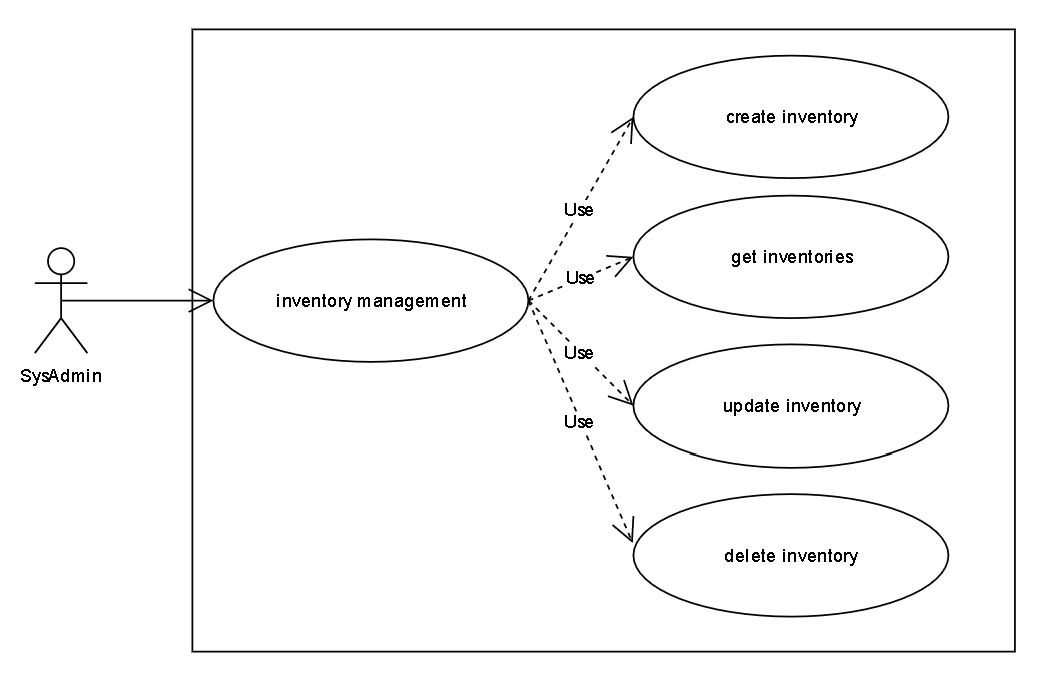
Rating
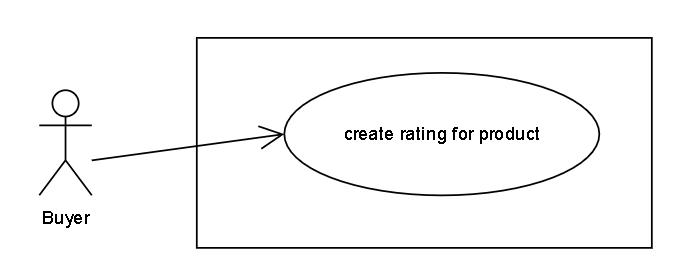
Access Control
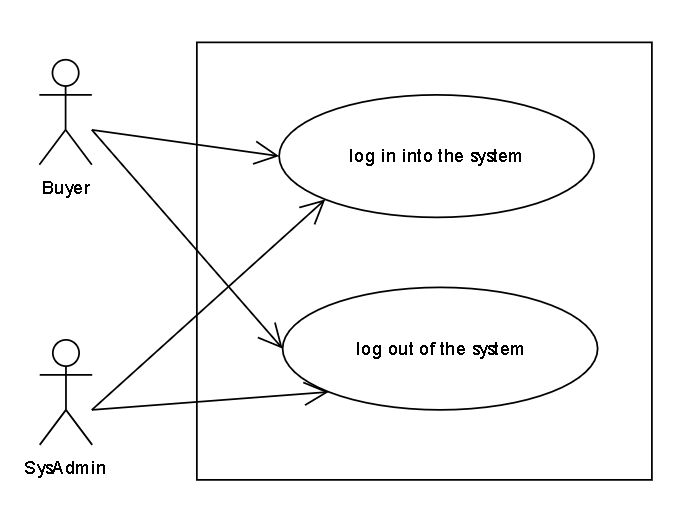
Event Storming: Events
Finding Events via Usecases
Product Catalog
- Buyer get products by filtering and sorting on price and name
- ProductListDisplayed (filter + sorting)
- Buyer get the detail of specific product
- ProductDisplayed
- SysAdmin product management
- ProductListDisplayed
- ProductCreated
- ProductUpdated
- ProductDeleted
- SysAdmin update product with inventory
- InventoryAssigned
Shopping Cart
- Buyer create the shopping cart with product
- ShoppingCartWithProductCreated
- Buyer get shopping cart with products
- ShoppingCartWithProductsDisplayed
- Buyer update the amount of product in the shopping cart
- AmountOfProductInShoppingCartUpdated
- Buyer delete product in the shopping cart
- ProductInShoppingCartDeleted
- Buyer check out the shopping cart
- ShoppingCartCheckedOut
- SysAdmin get shopping cart of buyers
- BuyersShoppingCartDisplayed
- SysAdmin update enabled/disabled shopping cart of buyer
- ShoppingCartEnabled
- ShoppingCartDisabled
Payment Process
- System
- ProductsValidated
- PaymentProcessed
- EmailSent
Inventory
- SysAdmin inventory management
- InventoryListDisplayed
- InventoryCreated
- InventoryUpdated
- InventoryDeleted
Rating
- Buyer create rating for product
- ProductRated
Access Control
- User log on the system
- UserLoggedOn
- User log out of the system
- UserLoggedOut
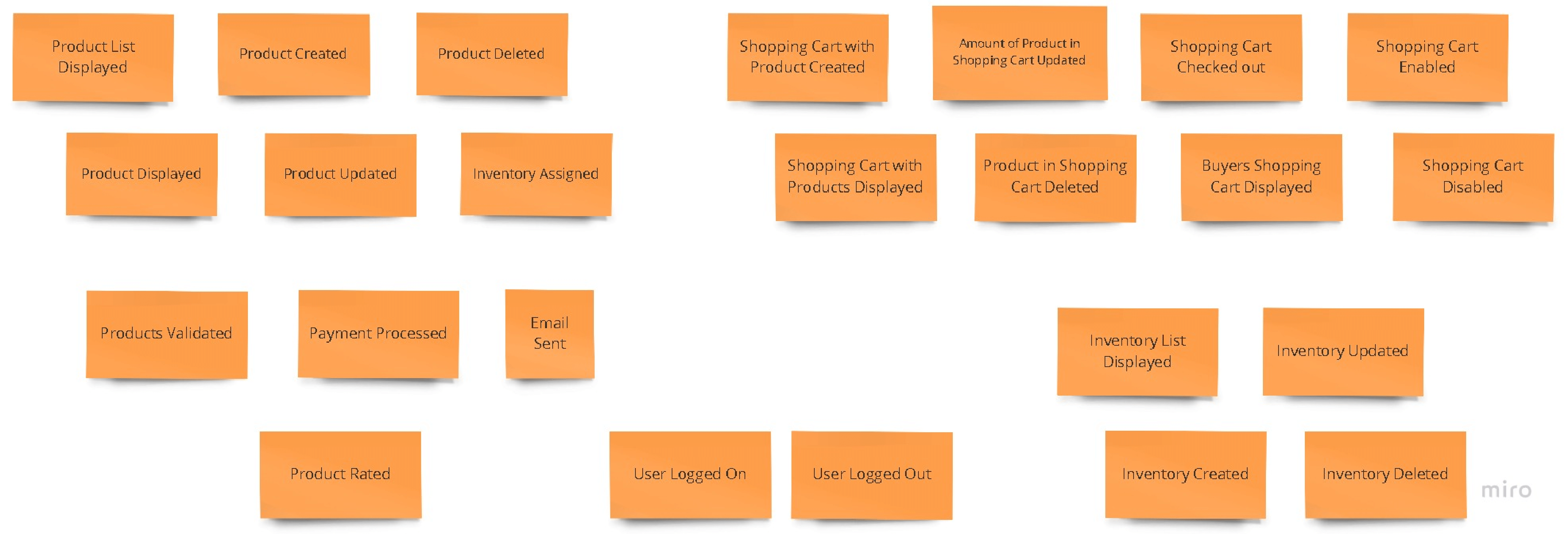
Event Storming: Roles, Commands and Events mapping
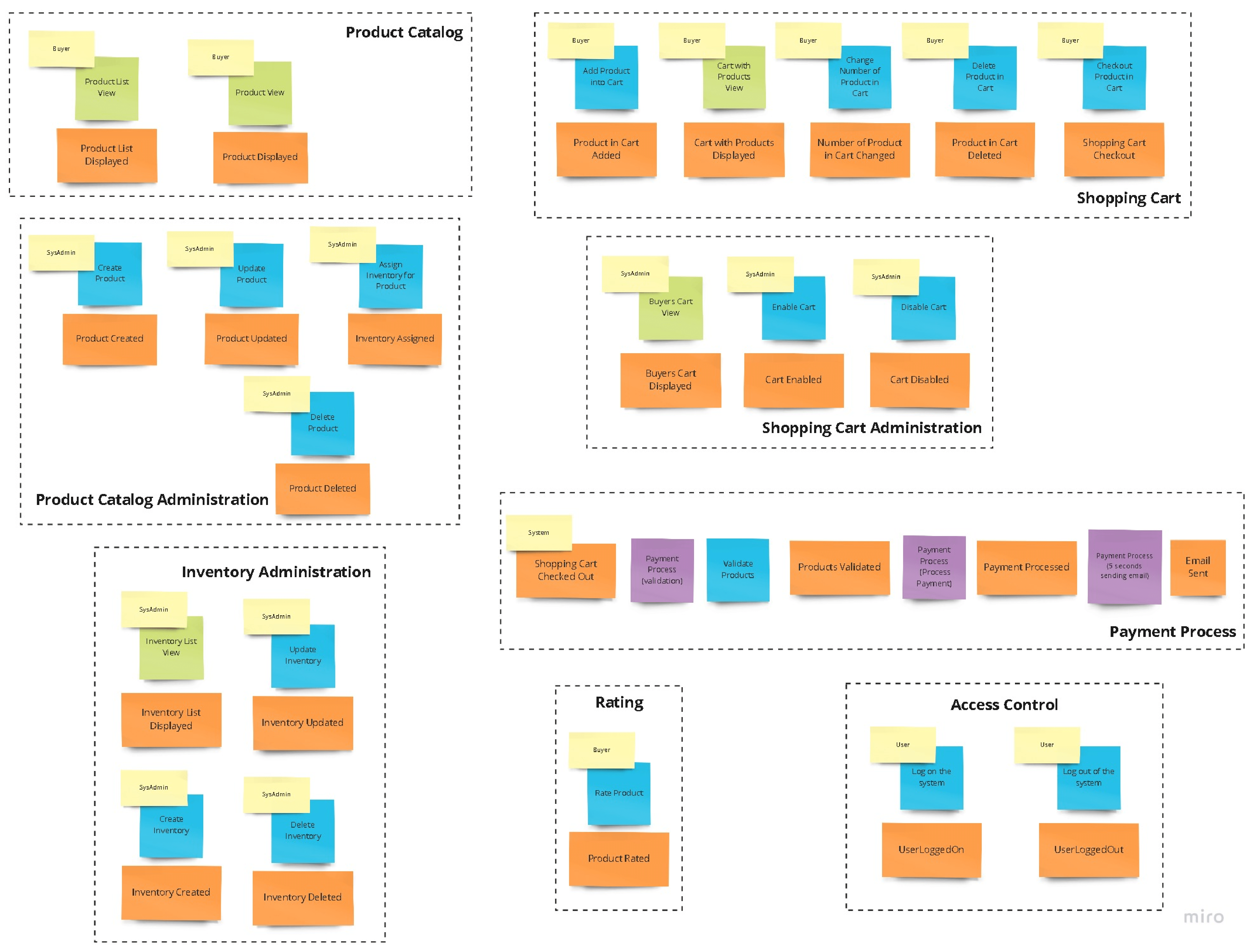
Event Storming: Bounded Context forming up
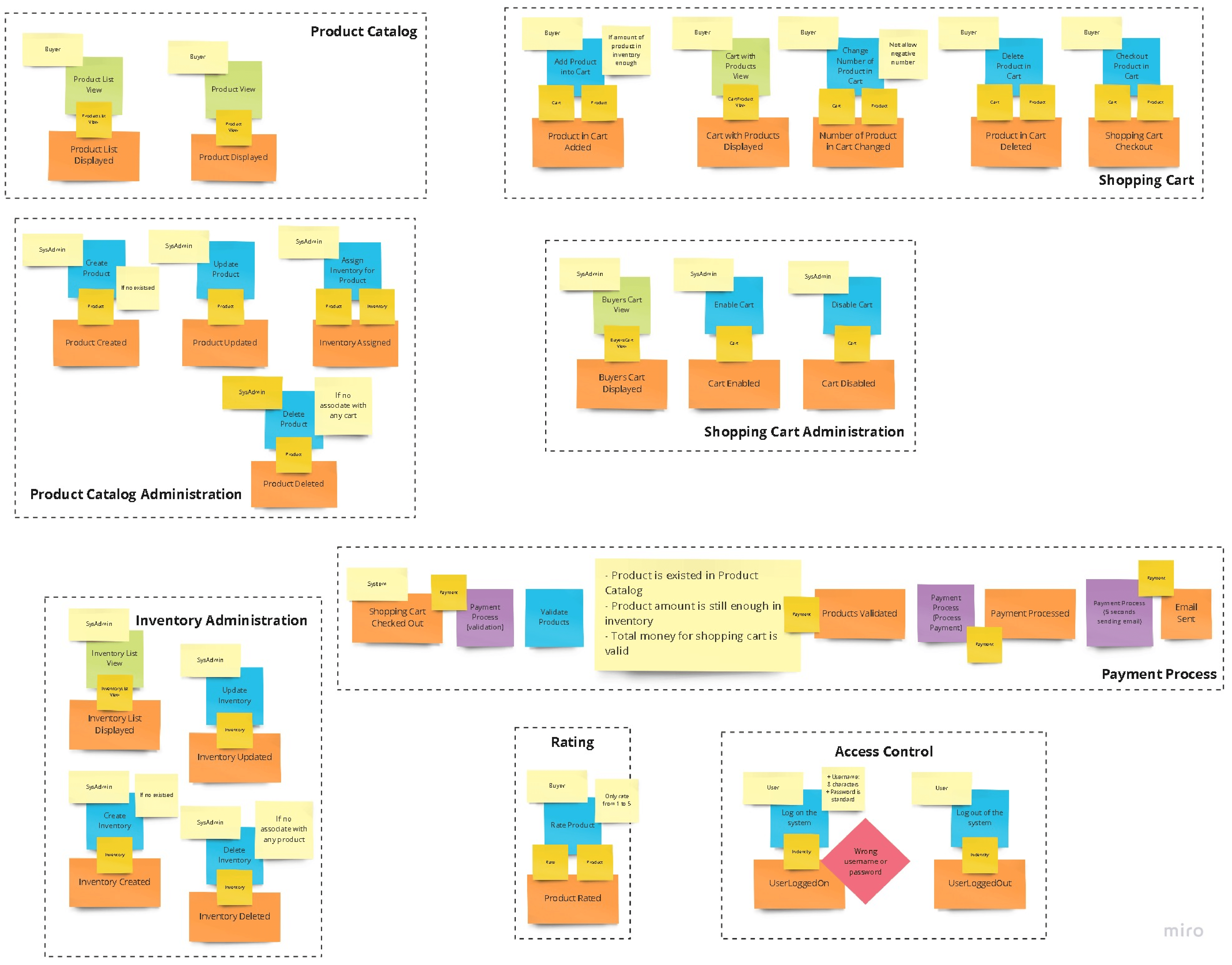
Event Storming: Context Maps
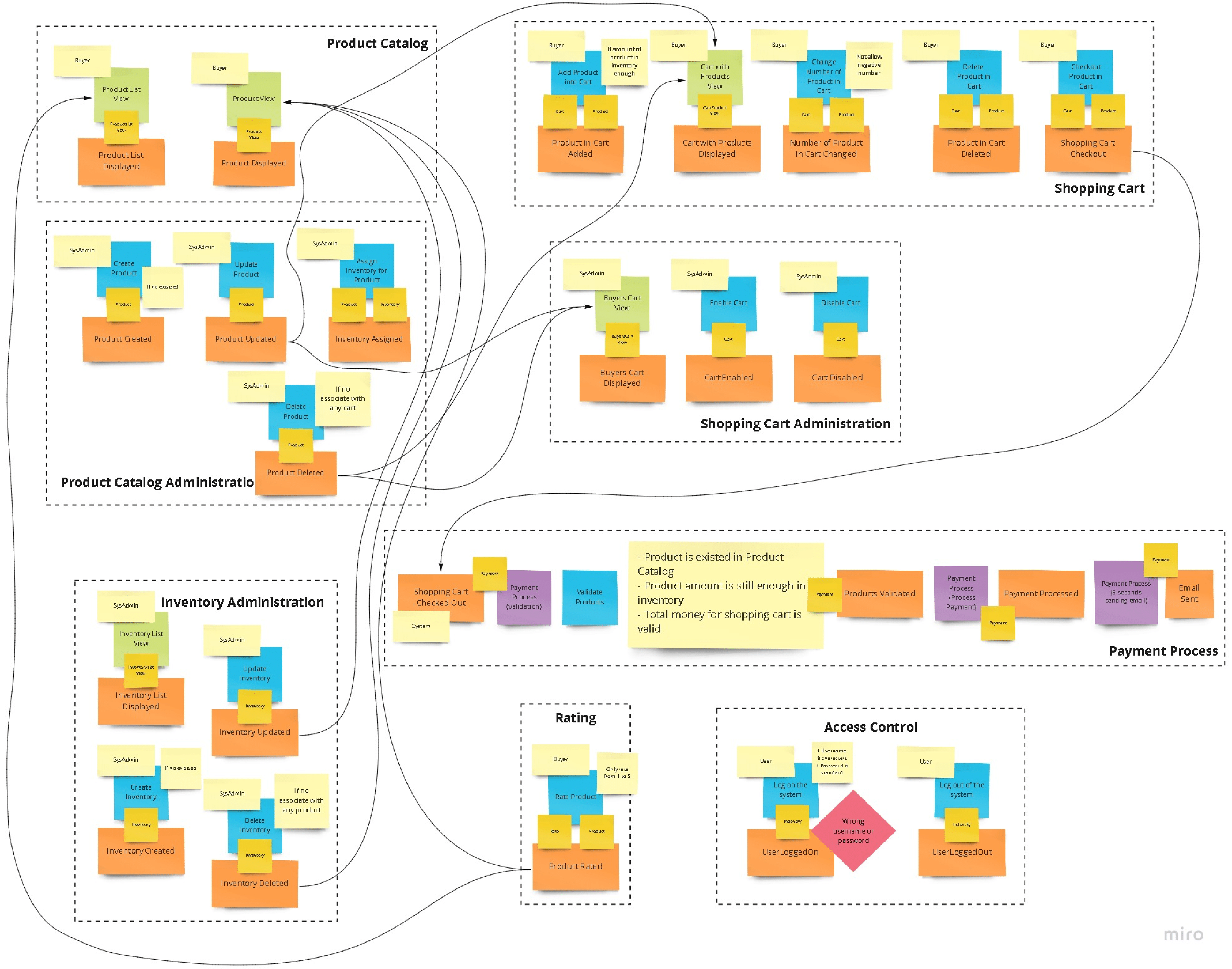
Finding Integration Events via Events
Product Catalog
- ProductListDisplayed
- ProductDisplayed
- ProductListDisplayed
- ProductCreated
- ProductUpdated (IntegrationEvent)
- ProductDeleted (IntegrationEvent)
- InventoryAssigned
Shopping Cart
- ShoppingCartWithProductCreated
- ShoppingCartWithProductsDisplayed
- AmountOfProductInShoppingCartUpdated
- ProductInShoppingCartDeleted
- ShoppingCartCheckedOut
- BuyersShoppingCartDisplayed
- ShoppingCartEnabled
- ShoppingCartDisabled
Payment Process
- ProductsValidated
- PaymentProcessed
- EmailSent
Inventory
- InventoryListDisplayed
- InventoryCreated
- InventoryUpdated (IntegrationEvent)
- InventoryDeleted (IntegrationEvent)
Rating
- ProductRated (IntegrationEvent)
Access Control
- UserLoggedOn
- UserLoggedOut
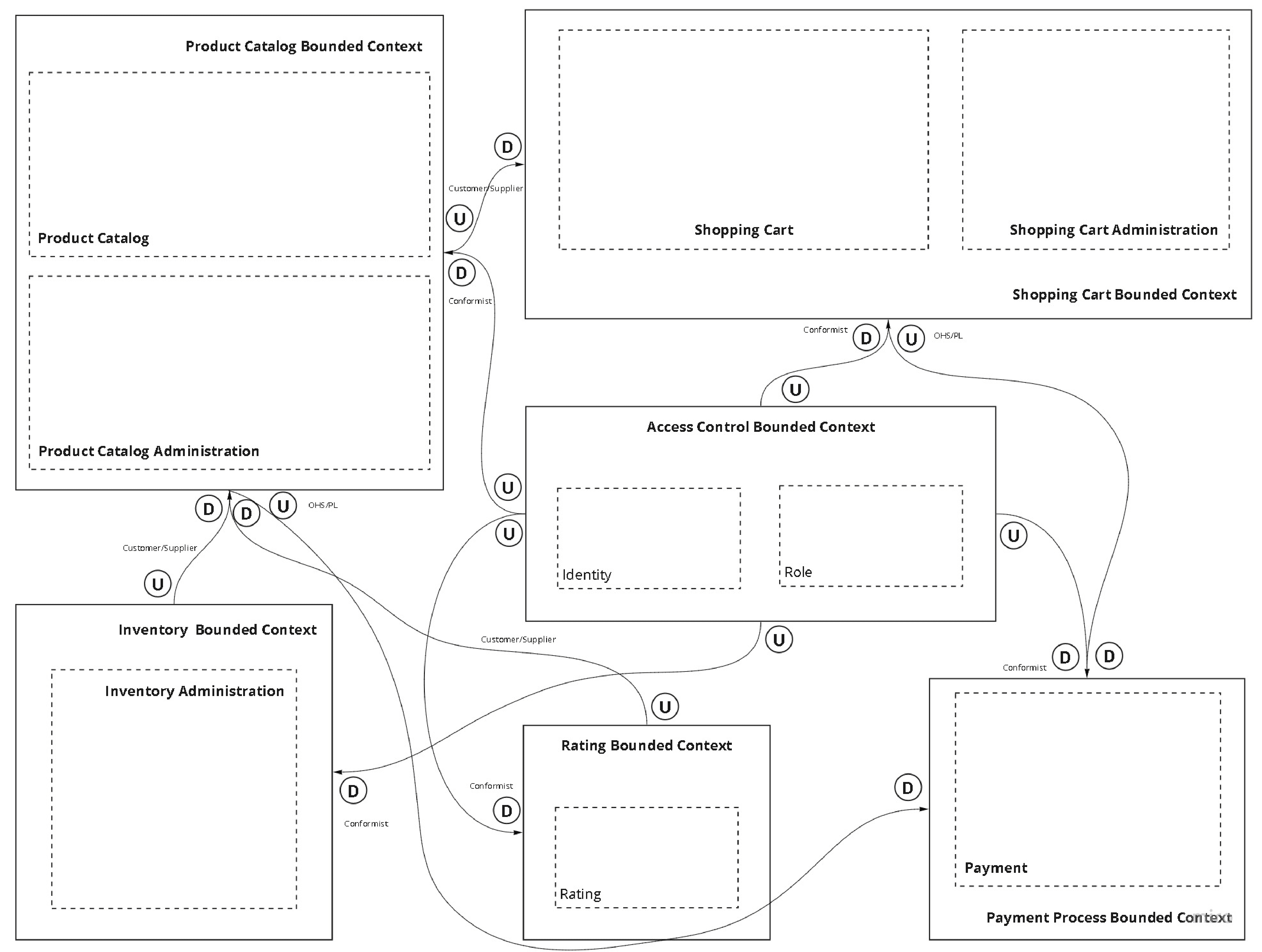
Development: User Story
Based on the business context to define User Stories
Product Catalog
- As a Buyer, I want to see the list of products with filtering, sorting on the home page (name, photo, short description, rating, and hot product flag which is a product with a lot of people see or buy).
- Whenever filtering with any price and name of the product, then the list of products need to narrow down with appropriate products.
- Whenever sorting with descending or ascending on the price or name of the product, then the list of products need to follow with this sorting.
- Whenever both filtering and sorting in action, then the list of products shall be effective by both of description above.
- As a Buyer, I want to navigate into the detail of one product with the basic attributes such as name, description, available product in the inventory, the inventory store information like stock address and location, a hot product flag (if has) and rating.
- As a SysAdmin, I want to manage a product (CRUD actions) and assign one existing inventory into the product.
Shopping Cart
- As a Buyer, I want to buy any product on the product catalog page (add this product into the shopping cart - one product will be added by default).
- As a Buyer, I want to see the product detail and buy this product if I like (add this product into the shopping cart - one product will be added by default).
- As a Buyer, I want to see the list of products I just added into the shopping cart, and I would like to see the summary information panel for the current shopping cart such as cart total cost, promotion item saving cost, subtotal cost, shipping cost, promotion shipping savings cost, total order amount on this page.
- As a Buyer, I want to update the amount of product in the shopping cart.
- Whenever updating amount of product happens, then the summary information panel needs to be updated accordingly to changes.
- As a Buyer, I want to delete any product in the shopping cart which they don't want to buy anymore.
- Whenever the deleting amount of product happens, then the summary information panel needs to be updated accordingly to changes.
- As a Buyer, I want to do check out my shopping cart.
- Whenever the number of products in the shopping cart is zero then this checks out process does not happen.
- While a shopping cart was checked out, the payment process starts.
- As a SysAdmin, I want to see shopping cart of all buyers with information about cart total cost, promotion item saving cost, subtotal cost, shipping cost, promotion shipping savings cost, total order amount.
- As a SysAdmin, I want to enable/disable any shopping cart of any buyer.
Payment Process
- Any Buyer can do the payment.
- In the moment of the payment process happening, we start to validation the item information, process for payment and subsequently send an email to the Buyer (because this is just the demo so we don't actually integrate with the payment gateway)
- Whenever any product information is invalid, then the payment process will be canceled and one email will be sent to Buyer for notification.
- Whenever ending this payment process, we mark the payment of this cart is processed status and send an email to let Buyer knows.
Inventory
- As a SysAdmin, I want to manage inventory (CRUD actions).
Rating
- As a Buyer, I want to rate for each product that I think is good (1 -> 5 stars).
Access Control
- Each Buyer/SysAdmin is a User.
- As a Buyer/SysAdmin, I want to log-in to the system.
- Whenever a user with a Buyer role does a login, then I will be brought to the product catalog page.
- Whenever a user with a SysAdmin role does a login, then I will be brought to the administration page.
- As a Buyer/SysAdmin, I want to log-out of the system.
One-off tasks
- Seeding the sample data for the product.
- Seeding the sample data for inventory.
- Seeding the sample data for the rating of a few products (randomness).
- Seeding a Bob user with SysAdmin role.
- Seeding a Mary and Alice users with Buyer role.
Development: Fine tuning user stories
Finding important statements starts with verbs
Product Catalog
- As a Buyer, I want to see the list of products with filtering, sorting on the home page (name, photo, short description, rating, and hot product flag which is a product with a lot of people see or buy).
- Whenever filtering with any price and name of the product, then the list of products need to narrow down with appropriate products.
- Whenever sorting with descending or ascending on the price or name of the product, then the list of products need to follow with this sorting.
- Whenever both filtering and sorting in action, then the list of products shall be effective by both of description above.
- As a Buyer, I want to navigate into the detail of one product with the basic attributes such as name, description, available product in the inventory, the inventory store information like stock address and location, a hot product flag (if has) and rating.
- As a SysAdmin, I want to manage a product (CRUD actions) and assign one existing inventory into the product.
Shopping Cart
- As a Buyer, I want to buy any product on the product catalog page (add this product into the shopping cart - one product will be added by default).
- As a Buyer, I want to see the product detail and buy this product if I like (add this product into the shopping cart - one product will be added by default).
- As a Buyer, I want to see the list of products I just added into the shopping cart, and I would like to see the summary information panel for the current shopping cart such as cart total cost, promotion item saving cost, subtotal cost, shipping cost, promotion shipping savings cost, total order amount on this page.
- As a Buyer, I want to update the amount of product in the shopping cart.
- Whenever updating amount of product happens, then the summary information panel needs to be updated accordingly to changes.
- As a Buyer, I want to delete any product in the shopping cart which they don't want to buy anymore.
- Whenever the deleting amount of product happens, then the summary information panel needs to be updated accordingly to changes.
- As a Buyer, I want to do check out my shopping cart.
- Whenever the number of products in the shopping cart is zero then this checks out process does not happen.
- While a shopping cart was checked out, the payment process starts.
- As a SysAdmin, I want to see shopping cart of all buyers with information about cart total cost, promotion item saving cost, subtotal cost, shipping cost, promotion shipping savings cost, total order amount.
- As a SysAdmin, I want to enable/disable any shopping cart of any buyer.
Payment Process
- Any Buyer can do the payment.
- In the moment of the payment process happening, we start to validation the item information, process for payment and subsequently send an email to the Buyer (because this is just the demo so we don't actually integrate with the payment gateway)
- Whenever any product information is invalid, then the payment process will be canceled and one email will be sent to Buyer for notification.
- Whenever ending this payment process, we mark the payment of this cart is processed status and send an email to let Buyer knows.
Inventory
- As a SysAdmin, I want to manage inventory (CRUD actions).
Rating
- As a Buyer, I want to rate for each product that I think is good (1 -> 5 stars).
Access Control
- Each Buyer/SysAdmin is a User.
- As a Buyer/SysAdmin, I want to log-in to the system.
- Whenever a user with a Buyer role does a login, then I will be brought to the product catalog page.
- Whenever a user with a SysAdmin role does a login, then I will be brought to the administration page.
- As a Buyer/SysAdmin, I want to log-out of the system.
Development: Rest API
Product Catalog
- Buyer see the list of products with filtering and sorting on price and name -> get products by filtering and sorting on price and name (GET)
- Buyer navigate into the detail of one product -> get the detail of specific product (GET)
- SysAdmin manage product -> create (POST), retrieve (GET), update (PUT) and delete (DELETE) a product
- SysAdmin assign one existing inventory into the product -> update product with inventory (PUT)
Shopping Cart
- Buyer buy any product on the product catalog page -> create the shopping cart with product (POST)
- Buyer see the list of products -> get shopping cart with products (GET)
- Buyer see the summary information panel (at the client side only)
- Buyer update the amount of product in the shopping cart (PUT)
- Buyer delete any product in the shopping cart -> delete product in the shopping cart (DELETE)
- Buyer check out my shopping cart -> check out the shopping cart (PUT)
- SysAdmin see shopping cart of all buyers with information -> get shopping cart of buyers (GET)
- SysAdmin enable/disable any shopping cart of any buyer -> update enabled/disabled shopping cart of buyer (PUT)
Payment Process
- System validation the item information
- System process for payment
- System send an email to the Buyer
Background processing with scheduler
Inventory
- SysAdmin manage inventory -> view (GET), create (POST), update (PUT) and delete (DELETE) an inventory
Rating
- Buyer rate for each product -> create rating for product (POST)
Access Control
- User log in into the system (POST)
- User log out of the system (POST)